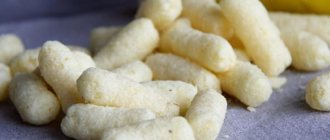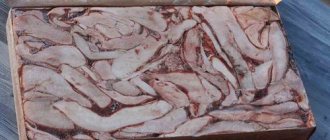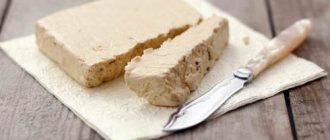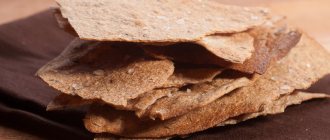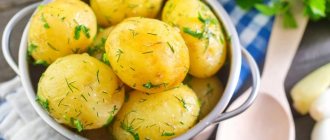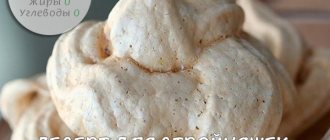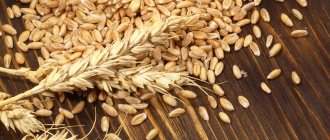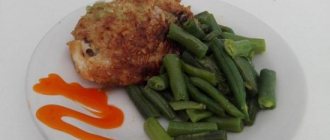Posted by:
Ashurbekova Shamsiyat Tofikovna
Endocrinologist. Specialist in preventive, functional medicine
Followers of a healthy lifestyle and those losing weight often look for an alternative to sweet muffins and cakes, buns and bread. One of the most popular substitutes for baked goods is bread. Even nutritionists prescribe a similar alternative for people on a diet. The beneficial properties of this product have been studied quite extensively. Today we will try to figure out which breads are the healthiest, whether they can be consumed by children and whether they help with weight loss.
Description
Experts say that cornbread is an excellent alternative to high-calorie wheat bread. Today they are widely popular, especially among athletes and people looking after their health. Cornbread is a very healthy and appetizing food.
It is based on a mixture consisting of corn flour and wheat. The energy value of 100 g of bread is 369 kcal, but it is worth considering that this figure may vary depending on the manufacturing technology. In any case, the energy value of the food is much higher than the calorie content of simple wheat bread, and therefore, in order to digest it, more energy will be required.
Agree, the calorie content of cornbread is high, but this food is still very beneficial for the body. After all, it contains a huge number of carbohydrates, which are responsible for the proper functioning of all organs and systems, as well as for energy production. In addition, it contains many minerals, trace elements and vitamins.
Useful properties of rice cakes
Let's consider the benefits of rice cakes for the human body.
Gluten free and low calorie alternative to bread
If you're on a low-carb diet or just want to control your calorie and carb intake, rice cakes can be a good substitute for other carbohydrates such as bread, muffins, crackers, chips and french fries.
Because they contain more air from the puffed rice and are not made from high-calorie flour, they tend to be lower in carbohydrates and calories than other snacks and similar ingredients. They may be able to satisfy your carb cravings without adding extra calories to your diet.
Another benefit is that they are naturally gluten-free (unless made with wheat, rye or barley flour) since rice is gluten-free.
Can be made from whole grains
Compared to other types of whole grain crackers or crusty breads, rice cakes generally contain less fiber. However, if you eat a few of them, especially if they're made from whole grains like brown rice and seeds, they can still provide some dietary fiber to meet your daily needs.
Whole grain rice cakes also provide small to moderate amounts of certain essential nutrients, such as manganese, B vitamins (especially niacin), and selenium, which have benefits such as maintaining healthy energy levels, maintaining normal blood sugar levels, and supporting bone health and promoting a strong immune system.
Convenient and versatile
Because they don't have much flavor on their own unless they contain added ingredients, rice cakes are versatile and can be used in a variety of recipes, both sweet and savory. For example, you can use them as the base for an avocado and salmon sandwich, or simply spread them with goat cheese or peanut butter.
They also don't require cooking, are inexpensive, shelf stable and don't require refrigeration, so they're easy to take with you on trips and outings.
Benefit
What are the benefits of cornbread? If you systematically use this product, your body will improve the condition of the skin, restore blood pressure, relieve blood clots from blood vessels, normalize sleep and the activity of the nervous system, saturate tissues and organs with adequate blood supply, prevent the formation of gastrointestinal and kidney diseases, and activate the functionality of the brain.
In addition, you will be freed from waste and toxins, cholesterol will disappear from your blood, plasma sugar levels will be restored, and metabolic processes that contribute to weight loss will accelerate. Your body will also be saturated with the right amount of energy, vital microelements, minerals and vitamins. All these beneficial qualities of cornbread allow you to maintain proper functioning of the whole body and health.
They are recommended by nutritionists for dietary and preventive-therapeutic purposes, in quantities of 3 to 5 pieces per day. This norm does not depend on health status and age. But here, of course, it is important to take into account contraindications.
Risks and side effects
If you have ever had an allergic reaction to rice, do not eat rice cakes.
Read ingredient labels when purchasing rice cakes and choose a brand that is made with easily recognizable ingredients rather than lots of sugar, preservatives and flavorings.
Conclusion
- What are rice cakes made of and are they beneficial? Rice cakes are made from puffed rice, sometimes rice flour, and in some cases other ingredients such as grains, sugar, salt and flavorings.
- Although they are generally quite low in calories, rice cakes do not contain many nutrients. The healthiest types are made from whole grain rice with no added sugar or artificial ingredients.
- The benefits of eating rice cakes are that they are convenient, versatile, and lower in calories than foods like bread and chips. However, they can quickly raise your blood sugar levels and are usually not very filling.
- Overall, watch your serving size and try pairing them with a source of satiating protein and healthy fats to make them more nutritious, such as cottage cheese, processed aged cheese, avocado, eggs or tuna.
If you liked the article, you can share it on social networks
With rye flour
It is known that corn-rye bread also exists. This food contains corn flour, wheat bran, peeled rye flour, water, dry yeast, 2nd grade wheat flour, a little margarine, rye malt and salt.
Corn-rye bread is incredibly appetizing, but it has little benefit for the body. After all, they contain yeast, margarine, and salt. But there is still a positive point here - this is an increased percentage of fiber. 100 g of this food contains 70 g of carbohydrates, 10 g of proteins, 18.5 g of fiber, 4.5 g of fat.
What is more benefit or harm from bread?
Many diets that exist today involve a complete rejection of bread, for the baking of which premium white flour was used. But the consumption of whole grain products and bread made from whole grain flour and containing bran, on the contrary, is encouraged. Such products contain fiber and retain various vitamins and microelements contained in grains. The process of digesting them involves a large expenditure of calories. Therefore, these products can be classified as dietary.
Those who want to lose weight can replace bread with bran with bread. There are many varieties of them in supermarkets. Each has its own characteristics, pros and cons.
Contraindications and harm
Everyone should study the benefits and harms of cornbread. Despite the above-mentioned benefits of the food, it can cause harm to the body. Many nutritionists and doctors believe that traditional wheat bread cannot be completely replaced in the diet with the food we are considering. Their opinion must be taken into account.
The product should not be consumed in large quantities: the daily intake should not exceed 5 pieces. If you eat more bread, the process of digesting food will become significantly more difficult, which will provoke metabolic disorders.
If you stick to moderate dosages, they will not pose any threat to the body. And when combined with the right food, they transform into a nutritious and healthy snack or serve as an excellent addition to a meal.
Is it possible to eat bread on a diet?
Many people classify bread as a dietary, low-calorie product. But this is far from true. 100 grams of bread contains approximately 300 kcal and, accordingly, their excessive consumption will certainly lead to extra centimeters on the waist. It is recommended to include no more than five loaves of bread per day in your diet. And of course, in order for this crispy product to have a beneficial effect on the body, they need to be consumed with healthy foods. So, low-fat varieties of soft cottage cheese, herbs and fresh vegetables go well with bread.
It is also necessary to understand which breads are worth buying, and which ones are better to avoid altogether.
What do they go with?
Cornbread is a universal food. They go well with coffee, compote, tea, freshly squeezed juice, and are used as a snack with various vegetables, hard cheese, boiled meat, a variety of cereals and preserves, berries, honey, jams, nuts, and fruit smoothies.

They can be eaten with soups or other basic dishes instead of plain bread. Often breads are used as a basis for sandwiches and snacks.
Digestion of food: how does it happen?
The food we eat, after entering the body, is a source of nutrients necessary for growth, energy, and metabolic processes. The body is a real chemical laboratory where food must be broken down into chemical components and then used for its intended purpose. The digestion time of food in different parts of the gastrointestinal tract varies significantly.
Food passes through the digestive system, undergoing a number of transformations, mechanical and enzymatic, in each section:
- In the mouth, food is crushed and moistened with saliva. In saliva, the enzyme amylase begins the breakdown of carbohydrates.
- Several enzymes are already “working” in the stomach, aimed at digesting proteins and fats and curdling dairy products. Hydrochloric acid helps break down, simultaneously destroying microbes and neutralizing some poisons. Absorption of nutrients does not occur in the stomach. The products are there for a maximum of 3-4 hours.
- Enzymes continue to work in the duodenum, breaking down food into even smaller components, turning it into mush. This is where the absorption of substances into the intestines partially begins.
- In the small intestine there is already an active process of absorption of the chemical components of food, which enter the blood, are cleansed in the liver and are transported to their destination (cells). All these processes take 7-8 hours.
- The remaining nutrients are absorbed in the large intestine. Here, the remains of undigested food (slags) can remain for up to 20 hours.
- Through the rectum, waste products are removed from the large intestine from the body.
The gastrointestinal tract pushes food through the digestive tract using periodic contractions of smooth muscles, a process called peristalsis. It is not difficult to calculate how much time the body spends on digesting food. The entire digestion process takes approximately 24 hours. From several kilograms of food eaten per day and 2-3 liters of liquid drunk, 200-300 g of undigested residues are removed.
Important! Even before eating, a conditioned reflex “wakes up”: saliva is released in response to the feeling of hunger, and gastric juice is released in response to tasty smells. Enzymes also begin to be released at a certain time if you eat food strictly according to the clock.
Classic recipe
We take:
- selected flax seeds – 100 g;
- sesame seeds – 50 g;
- premium corn flour – 200 g;
- large selected sunflower seeds – 100 g;
- olive oil – two tbsp. l.;
- pumpkin seeds – 50 g;
- sea salt – 0.5 tsp;
- boiling water – 200 g.
To create 5 servings of cornbread, follow these steps:
- First, mix all the dry ingredients, add olive oil and water.
- Place the resulting dough on a baking sheet in an even layer, cut into equal rectangles.
- Sprinkle the dough with salt and place in the oven.
- Bake at 150°C for approximately 50 minutes.
Appetizing and healthy food is ready!
Recommendations for use
If you like to snack on rice crispies regularly, choose ones made with whole grain rice, such as brown rice, plus simple ingredients like sea salt or cinnamon. Avoid those that contain added sugar or artificial flavors, and be mindful of how much sodium you consume if you are salt-sensitive.
To make rice cakes more filling and reduce your portion size, try pairing them with a source of filling protein, such as cottage cheese, aged cream cheese, or tuna. This results in less of a spike in your blood sugar and also helps you control your hunger for longer.
Healthy fats such as avocado or almond butter are also good options to eat with rice cakes as they will keep you feeling fuller longer.
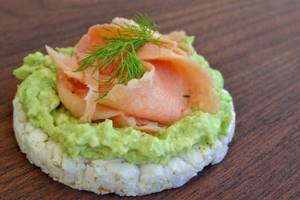
A great option to use rice cake as a base for an avocado sandwich.
With rice
What are Rainbow Rice Corn Crisps? They are made from corn and whole grain rice. They are great for sandwiches, good as a light snack when you need to satisfy your hunger.
A package of such bread weighs only 100 g. They contain sea salt (3%), whole grain rice and corn (20%). You need to store food in a cool place. It is manufactured in the European Union. One loaf of bread (100 g) contains:
- 5.5 g carbohydrates (82 g);
- 0.2 g fat (2.6 g);
- 0.5 g protein (7.6 g);
- 110 KJ/27 kcal (1640 kJ/400 kcal).
Features of the choice of bread according to composition
- Whole grain raw materials
Whole grain, unlike processed grain, retains the shells and films, and with them the most valuable elements for the functioning of the gastrointestinal tract - dietary fiber. Whole grain products have a lower glycemic index, which means carbohydrates are absorbed more slowly, keeping you full for longer. In other words, in order to get full in the moment, you can eat less bread than a loaf if you started snacking on it.
- Cellulose
The increased fiber content (sometimes it is added to the breads additionally) is another bonus of eating breads. Indigestible by digestive enzymes, these components help the gastrointestinal tract and improve intestinal permeability. Pay attention to the content of dietary fiber - it is optimal if there is at least 6 g per 100 g of product.
- Low fat
Crispy snacks should not contain a lot of fat, especially saturated fat. They are not as destructive as trans fats from margarine baked goods, but they are not nearly as healthy as poly- and monounsaturated fats. To make the breads tasty, vegetable oil is added to them during the process. Make sure that the amount of fat does not exceed 2.5 g per 100 g of product.
Some cereals or seeds in the composition may increase the amount of fat and, as a result, calorie content. But this nutrient will be unsaturated, which means it will have a positive effect on the functioning of the cardiovascular system and other internal organs.
- Salt
Table salt is the most accessible and cheapest flavor enhancer. Typically, snacks such as chips, crackers, and crackers have a concentrated salty taste. Bread should not contain a lot of salt: no more than 120 mg per 100 g of product.
The most popular brands are Bite (buckwheat contains only cereals, water and table salt, corn-rice with onions contains cereals, bran, dried onions and sea salt), Dr. Korner (good composition, sweet ones contain flavoring, sweetener and coloring), Finn Crisp (rye flour, yeast, water, salt).
Russian bread
Consider Healthy Cornbread. They are manufactured by LLC First Dietary and Baby Food Plant, located in St. Petersburg. The package contains 90 g of breakfast cereal, which contains salt and corn grits. This product is gluten and GMO free.
Its nutritional value is as follows: 80.8 g carbohydrates, 8.1 g protein, 1.7 g fat. Energy value: 371.1 kcal/1554.9 kJ.
The product can be stored for no more than six months at a temperature not exceeding 20 °C and humidity not exceeding 75%. These are great breads with a distinct corn flavor.
Composition of bread and crispbreads
The main ingredients of a regular bread loaf are flour (seed rye, wheat, oatmeal or whole grain), eggs, yeast, sourdough, butter, sugar, water/milk. Good breads contain only flour and water with salt. Additional components include bran, wheat germ, various types of cereals, and spices to enhance the taste and make it resemble bread (coriander, garlic, cumin). At the same time, bread may contain different flavor enhancers and components encrypted with the letters E, so check this issue carefully before purchasing.
The secret of a quality product is in its label. Study the packaging and see what the slices are made of. The shorter and simpler the composition, the better the product. For example, cereal breads can contain exclusively ground and crushed cereals: buckwheat, oatmeal, rice, pearl barley and others.
The list of ingredients may include different grades of baking flour, oatmeal, wheat bran, peeled rye flour, yeast, fructose, other sweeteners and flavorings (if these are round sweetbreads), milk powder, fiber and malt. It is possible to add seeds - flax, sesame. If you see in the list such items as margarine, soy lecithin emulsifier, dye, then you should not take this pack - look for something with a less colorful composition.
Don't confuse diet bread with snack bread. The latter are more like a cracker and contain paprika, dried onions, garlic, oregano, sea salt, basil and other spices.
Nuances
Nutritionists advise paying attention to bread when a person suffers from heartburn when eating plain bread, which is due to the presence of yeast in its composition. The B vitamins included in their composition not only enhance the metabolism of fats and carbohydrates, but also give a radiant appearance to nails, hair and skin of the hands. And macro- and microelements improve the functioning of the immune system.
Children under four years old should not eat crispbread. This is due to the fact that their stomach is not able to digest such rough food.
All nutritionists on our planet are still arguing about the harm and benefits of bread. But it must be admitted that this food has a beneficial effect on the human body and helps it get rid of excess accumulations.
Sprouted wheat bread

Small seedlings have considerable energy potential. When eating them, a person feels a surge of strength and vigor. The elements included in sprouted grains strengthen the immune system, improve the functioning of the gastrointestinal tract, saturate the body with vitamins, and remove toxins.
You will have to stop eating sprouted wheat bread:
- children;
- people with metabolic diseases;
- citizens in the postoperative period.
Experts recommend giving preference to products that, in addition to sprouted grains, also contain dried apricots or raisins.
At what age can bread be given to children?
Despite the fact that the benefits of bread for the body are great and their harm is minimal, experts recommend giving snacks to children after three years of age. In this case, the daily norm should include no more than 2 - 3 pieces. The product contains coarse fibers that are difficult for a fragile child's stomach to digest, which is why it is strictly forbidden to give the product to very young children: they can lead to stool problems, bloating, and pain in the stomach.
Before introducing bread into your diet, you need to check if your child is allergic to them. You should give your baby a small piece of the briquette and monitor his reaction throughout the day. If no changes are observed, you can give the product, but in minimal quantities.
Attention! If any symptoms indicating an allergy appear, your baby should stop eating bread and consult a doctor.
Dairy
Raw milk leaves the stomach slowly, pasteurized milk even slower, and boiled milk even slower. Milk that is rich in fat passes through the stomach more slowly than milk that is low in fat.
Skim milk, ricotta, low-fat cottage cheese, feta cheese, and homemade cheese are digested in about 90 minutes.
Milk is completely digested within 12 hours. Tea or coffee with milk: 24 hours.
Whole milk cottage cheese - 2 hours
Hard cheese made from whole milk, such as Dutch and Swiss, will require 4 to 5 hours to digest.
Fermented milk drinks – 1 hour
How much food is digested on average depending on a person’s age
In the stomach of a newborn baby, which is able to digest only milk, food remains for no more than 3 hours. At this age, the volume of the organ is small, food comes in small portions and leaves the stomach quickly, hence the need for frequent intake of nutritional formula or milk.
In an adult, the time a bolus of food remains in the stomach depends on its volume, the quality composition of the products, their compatibility, and the state of the digestive organs.
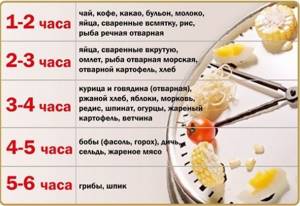
How long does it take for different types of food (raw and cooked foods) to be digested in the human stomach?
On average, in a healthy state of the digestive system - from half an hour to 5-10 hours. In older people, the elasticity of the walls of the gastrointestinal tract decreases, acidity and the amount of enzymes produced change. These changes increase the period of processing of the food eaten and its evacuation into the intestines.
How long do various foods take to digest (Now it’s clear what’s best to eat before bed)
All products can be divided into four groups according to the duration of their processing by the stomach. How long does it take to digest what we eat?
Group 1. This includes mainly carbohydrates, processing time: 30-35 minutes. These are broths, light salads, natural juices, as well as fresh (raw) vegetables and fruits.
Group 2. This category contains proteins and some fats, processing time: 1-2 hours. This group includes eggs, milk, poultry, lean fish and seafood.
Group 3. These are products containing starch and complex carbohydrates, processing time: 2-3 hours. This includes nuts, legumes, cottage cheese, hard cheese, potatoes and cereals.
Group 4. This list includes foods that take longer to digest than others or are not digested at all. This includes coffee, canned food, stewed meat, mushrooms, bread and pasta.
Sometimes, without being a doctor, it is worth delving into the details of the digestion process, assessing how long food passes through the gastrointestinal tract, and comparing the absorption of foods by duration. Why know how to digest food quickly? The body is good at this matter, let it deal with it itself. Because the unconscious choice of unsuccessful combinations makes the stomach harder and provokes complications. Let's see why it is important to know the digestion time of food.
Today there is a lot of talk about proper and balanced nutrition. Unfortunately, it is not always possible to follow a specially selected diet and daily routine. Either a hard day at work, or a dream trip to a tropical island, or... an unbearable desire to eat something literally before going to bed.
- Drinking water and other liquids during meals. It is not recommended to drink water and drinks during meals, as they dilute the gastric juice and the digestion time of food increases (or the food is not completely digested).
- Many products after heat treatment (cooking, frying, stewing) take longer to be absorbed in the human body (the time for assimilation of products increases).
- Cold food is digested faster over time.
- Food eaten at lunch is digested faster than food eaten in the morning and evening.
- The speed of digestion in the stomach and absorption in the body is greatly influenced by the type and amount of food consumed, since different foods are absorbed at different speeds (from several minutes to several hours), and when they are mixed, the digestion time can increase.
Of the listed factors that significantly influence how quickly the food eaten and drinks drunk will be digested, let us dwell in more detail on the speed of digestion of all products separately and consider how many hours various foods are digested (meat, fish, cereals, vegetables, fruits, etc. .) in the human stomach.
